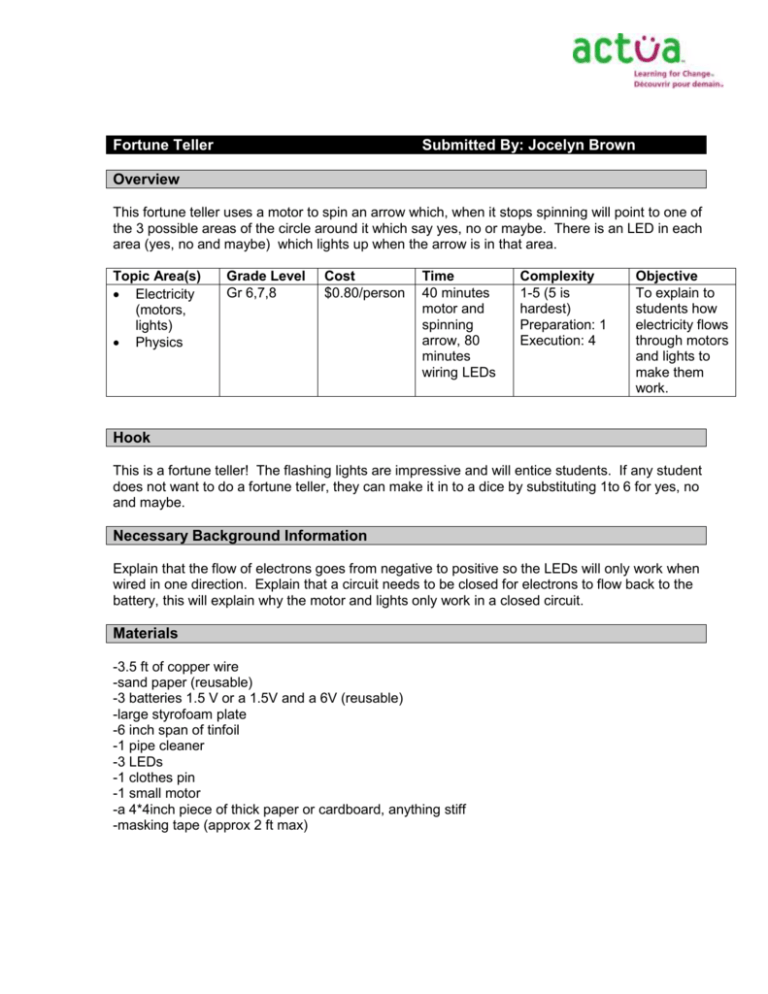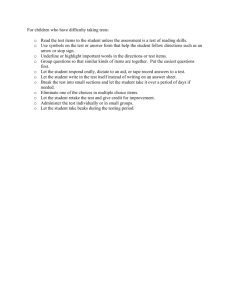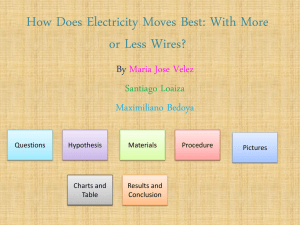Electricity (motors, lights)
advertisement

Fortune Teller Submitted By: Jocelyn Brown Overview This fortune teller uses a motor to spin an arrow which, when it stops spinning will point to one of the 3 possible areas of the circle around it which say yes, no or maybe. There is an LED in each area (yes, no and maybe) which lights up when the arrow is in that area. Topic Area(s) Electricity (motors, lights) Physics Grade Level Gr 6,7,8 Cost $0.80/person Time 40 minutes motor and spinning arrow, 80 minutes wiring LEDs Complexity 1-5 (5 is hardest) Preparation: 1 Execution: 4 Objective To explain to students how electricity flows through motors and lights to make them work. Hook This is a fortune teller! The flashing lights are impressive and will entice students. If any student does not want to do a fortune teller, they can make it in to a dice by substituting 1to 6 for yes, no and maybe. Necessary Background Information Explain that the flow of electrons goes from negative to positive so the LEDs will only work when wired in one direction. Explain that a circuit needs to be closed for electrons to flow back to the battery, this will explain why the motor and lights only work in a closed circuit. Materials -3.5 ft of copper wire -sand paper (reusable) -3 batteries 1.5 V or a 1.5V and a 6V (reusable) -large styrofoam plate -6 inch span of tinfoil -1 pipe cleaner -3 LEDs -1 clothes pin -1 small motor -a 4*4inch piece of thick paper or cardboard, anything stiff -masking tape (approx 2 ft max) Safety Considerations (if necessary) When using 6V batteries warn them about short circuiting by attaching positive and negative directly together. Procedure For spinning arrow (motor component): Make a hole in the centre of the styrofoam plate to place the motor through. The bottom of the plate is the good side of your fortune teller. Place the motor in the hole with rotating shaft upwards. Tape it in place without covering the two bottom rings and without hindering the rotation of the shaft. Sand the ends of three pieces of copper wire until they are clean and shiny Two wires should be sturdily attached to the two rings on the back of the motor. One of the wires coming from the motor must get fastened to one side of the battery. Try for max surface area of the battery end touching the copper wire end (bend copper wire end into a spiral if you want) then put aluminium foil on top of the battery end and the wire and keep it all in place with masking tape. On the other end of the battery (which end does not matter) attach the third wire that is not yet attached to anything. Attach it in the same way you did the other end of the battery (with foil and masking tape) Now you have an open circuit since there are two wires that are only attached to something on one side. Poke the two unattached ends through the plate so they are on the Use masking tape to fasten the battery to the underside of the Styrofoam plate. Wind the free ends of wire around the back ends of a clothes pin and wrap the ends with tin foil. Keep that in place with masking tape. When you press the back part of the pin closed it will complete the circuit and the motor will run. Make a cover out of thick paper in the form of a circle (radius of approx 2 inches) to cover the hole in the Styrofoam for your motor. Make a tiny hole in the centre of your cover to allow the rotating shaft to pass through. Put it in place but don’t tape it permanently, you will have to put wires through it in future steps. Make an arrow out of a pipe cleaner and wrap masking tape around the end. Poke the shaft of the motor into the masking tape on the arrow. This should make a spinning arrow on your Styrofoam plate when the wires are connected. This also will have to be removed in future but it should come on and off easily. Divide the circle around your arrow into three areas and write YES, No, and MAYBE, one is each quadrant. Now when your arrow stops spinning it will point in the area of one out of the three future telling options! For light component (LED = Light Emitting Diode): Cut out a ring of tin foil with inner radius shorter than your arrow. Cut the ring into 3 equal pieces which will be glued onto each quadrant (yes, no and maybe) Cut out another tin foil ring with outer radius smaller than the thick paper cover you made earlier. This ring stays in one piece and will later be glued onto the paper cover you made earlier. Sand the ends of another 6 inch piece of copper wire. When gluing or taping the tin foil ring made earlier onto the paper cover, attach the sanded copper wire between the two parts. (Make sure that there is good contact between the wire and foil so that electrons can flow) The other end of the copper wire must get poked through to the bottom side of the foam plate. Now it’s time to put in your lights! LEDs are picky, they can only be wired in ONE direction to work. Each diode has two metal wires coming from it, one long, one short. Locate the long end of your diode. Poke the diodes into the Styrofoam plate. This must be done with the long end (side of diode which gets attached to the positive end of the battery) getting poked through both the Styrofoam but also the far edge (near outer radius) of the foil ring). One diode goes in each quadrant. The piece of wire that was poked through the Styrofoam must be attached to the negative end of a 6V battery. Sand yet another piece of copper wire at both ends and attach it to your rotating pipecleaner arrow so that one end drags on the inside (small) tinfoil ring and one side drags on the outside (large, three piece) tin foil track. Now sand three more wires at both ends and use them to attach the other(short) end of the diode to the negative side of the 6V battery. There should be 3 wires going to the negative side of the battery. Now when you squish the clothes pin shut it should spin the arrow and turn on the light in the appropriate quadrant! Learning Outcomes This project works because the batteries supply a flow of electrons from negative to positive through the wires, motor and LEDs. This project introduces children to electricity basics and teaches them how motors and lights function with electricity. Further Resources (optional) NOTE: pictures will soon be attached at a later date






